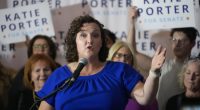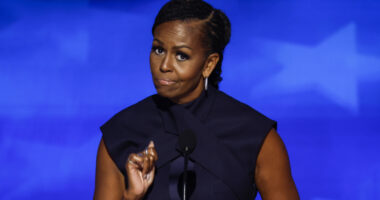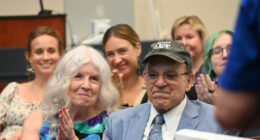Anthony Albanese is getting a $15,000 pay rise as many Australians struggle financially – bumping his package above $622,000.
Australia’s Prime Minister is paid significantly more than other world leaders running nations with bigger economies and populations.
Federal politicians, senior public servants and departmental secretaries are receiving a ‘relatively modest’ 2.4 per cent pay rise from July 1.
This is thanks to a Remuneration Tribunal ruling putting executive salary increases in line with inflation, which will see backbench MP pay rise from $233,660 to $239,268.
Albanese’s pay is rising from $607,516 to $622,097, which is more generous than Donald Trump’s base pay of $609,400 in Australian dollars.
Australia’s Prime Minister also gets more than his UK counterpart Keir Starmer on $360,282 and Canada’s PM Mark Carney on $469,600.
Treasurer Jim Chalmers will see his salary rise from $438,111 to $448,625.
Foreign Minister Penny Wong’s pay will be equal as Leader of Government in the Senate.

This pay rise, which will see Anthony Albanese’s salary rise by $15,000, is in line with the inflation figure for March
Opposition Leader Sussan Ley’s salary will jump to $442,646.
This is higher than Home Affairs Minister Tony Burke’s $418,719 salary as Leader of the House.
But it’s lower than Deputy Prime Minister Richard Marles on $490,499 as the holder of the Defence portfolio.
An Australian needs to earn $408,974 to be among the top 0.8 per cent of income earners, based on tax office data, and Cabinet ministers are certainly among that elite.
Australia’s most powerful ministers typically earn four times the average, full-time salary of $102,742 and ten times the full-time minimum wage of $49,300.
The Remuneration Tribunal argued its 2.4 per cent increase for MPs was appropriate.
‘The tribunal notes the domestic economy is continuing to stabilise following a period of elevated inflation and that many Australians continue to experience financial challenges,’ it said.
‘In the current economic context, the tribunal considers an increase of 2.4 per cent appropriate.’

Opposition Leader Sussan Ley’s salary will jump to $442,646
‘This adjustment reflects a measured approach, balancing the need for restraint given economic conditions with the recognition of the upward pressure on household costs.’
The 2.4 per cent increase for MPs was lower than the Fair Work Commission’s annual wage review, which awarded a 3.5 per cent increase to the 2.9million Australians either on the minimum wage or an award.
The tribunal, an independent body, said it had a longstanding policy of ‘modest’ increases in pay for politicians and bureaucrats.
Since 2016, pay levels for Australia’s most senior public servants has risen by 18.7 per cent, which it argued was more moderate than the 25.6 per cent increase in the wage price index for the same period.
Former Liberal Democrats senator David Leyonhjelm, a libertarian campaigning for smaller government, said Australia’s high pay for politicians produced careerists without life experience outside politics.
‘It turns politics in Australia into a career, a well-paid career,’ he told Daily Mail Australia.
‘I don’t think taxpayers get good value for money but the big thing is that many of the incumbents in those roles can’t do as well outside of politics so they have an additional incentive to hold on to their jobs, hold on to their positions in order not to lose the benefits.

Treasurer Jim Chalmers will see his pay rise from $438,111 to $448,625
But Warren Snowdon, a former federal Labor minister who was in Parliament for 33 years, said politicians work hard and deserve the money.
‘I won’t comment on the money but I think it’s a fallacy they don’t work hard,’ he told Daily Mail Australia.
‘I don’t know of one member of Parliament that doesn’t work hard.
‘In my own case, I was in the Parliament for almost 33 years and for most of that time, I was at home, on average, eight nights a month, if you exclude the Christmas period.
‘I had to travel inside the electorate which was 1.3million square kilometres, very diverse communities; you can’t be seeing yourself as someone who’s an absent member.’
But Mr Leyonhjelm, who was in the Senate for five years, said too many politicians were addicted to the pay and the perks.
‘I subscribe to the latter view that you’re not in it for the money, it’s not a career and you should have a life before you go into politics, you should have a life after you come out of politics so that you don’t lose touch with what you’re there for and the people you represent,’ he said.
‘You can get into a philosophical argument here – is politics a profession, a calling or should it be people who spend a few years serving the public and go back to a normal life?’
‘We should treat a political role as a temporary position no matter who you are.’
While Australia’s most senior politicians are well paid by international standards, their remuneration packages are only a small fraction of what Australia’s top bureaucrats get.
‘It’s high by international standards, it’s low by bureaucratic standards,’ Mr Leyonhjelm said.
‘So then the argument becomes – “Should the Prime Minister be paid more or less than the bureaucrats who are basically at his bidding?”‘
Reserve Bank of Australia Governor Michele Bullock is on a total remuneration of $1.057million from a base salary of $811,108.
But corporate chief executives are paid considerably more than Cabinet ministers or departmental bosses.
Commonwealth Bank chief executive Matt Comyn is on $8.977million with bonuses, on top of his base salary of $2.5million.
Thousands of Aussies have still called for politician’s pay to be based on performance.
‘Imagine if they got paid on performance,’ one said.
‘Results based remuneration is the most appropriate form of remuneration for politician,’ another added.
‘It should be performance based – a huge deduction is warranted,’ a third declared.








